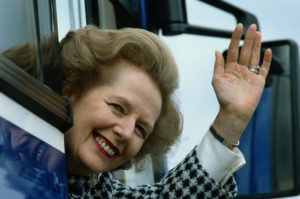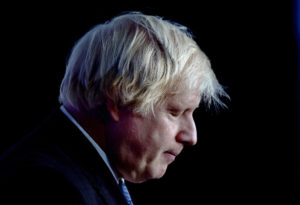There is nothing like extreme weather to snap a crisis into focus. During the icy winter of 1978-79, the government’s attempts to tackle inflation, and the ensuing wave of pay strikes, all played out amid snowdrifts, burst pipes and icebound roads, crystallising the sense that long-established systems no longer worked. The general mood was easy to gauge: things could not go on like this.
Today, it seems we are here again. Britain, we are told, is on the cusp of its Second Winter of Discontent. But if the struggle for power between government and unions 44 years ago seems eerily similar to today, look closer.
For a start, we are not used to all this — whereas in 1979, the chaos was wearily familiar. It marked a return to the years when governments of both parties had tried and failed to curb union power. A “winter of discontent” had been a long time coming: the Telegraph had warned one was imminent in 1972, as had union leader Hugh Scanlon in 1974, and the new Conservative leader Margaret Thatcher in 1975.
From the mid-Seventies, Labour seemed to have settled with the unions; but when a last-ditch deal broke down in 1978, the country was plunged back into crisis. As the post-war industrial relations consensus finally froze to death, the old images flashed before the public’s eyes one last time. Huge strikes in the car industry. Union leaders trooping into No 10. Strikes stopping trains and shutting down petrol stations and unheated schools. Jumpy talk of the government sending in the troops.
Today’s wave of strikes is a novelty precisely because of the new, less union-friendly consensus that slowly took shape in the years after 1978. The unions were then at the apex of their power, and rapidly losing public sympathy. Today, they are struggling to recover from decades of weakness, and attract much more support than at the end of the Seventies. In 1977, The Sun reported a Marplan poll which suggested 80% of the public thought “union leaders have ‘a lot’ of power and influence in governing the country”. Amid the strikes last August, a poll conducted by Ipsos found only 9% of the British public thought workers had too much power.
Since the war, governments’ main way of squashing wage inflation had been “incomes policy”, by which ministers asked, or ordered, workers to accept a limit on pay increases. The Winter of Discontent was triggered when the Prime Minister James Callaghan insisted on setting this at 5%, well below inflation. Something of this is visible in the Sunak administration’s insistence on below-inflation hikes for public sector workers. But the crucial difference is that Callaghan could reasonably expect the private sector to stick to his limit. In September 1978, the Ford car company was so keen to comply that it endured weeks of strike action before folding and coughing up 17% — even though it could have afforded that at the start. Imagine that now.
Today, most companies don’t have to worry about either powerful unions demanding pay increases or government demands for pay restraint. Only a sixth of private sector workers are in a union at all; many are on insecure contracts. Of course, there are a few exceptions: last winter, strike threats by Unite supermarket workers won pay rises that Tesco had previously said “would not be sustainable”. But 1979 was another world: that January, Mrs Thatcher claimed in the Commons that a full third of factories had suffered all-out strikes in the previous two years.
So, the shock of the Winter of Discontent wasn’t private-sector workers taking industrial action, but low-paid public sector staff, often women, in workplaces that were not obviously militant, such as care homes, and hospital laundries and kitchens. The union to which many of these workers belonged, the National Union of Public Employees, had only recently become radical. Public sector pay had been cut, in the aftermath of economic crisis and high inflation, and some NUPE members were so ill-paid they had to claim in-work state benefits.
Workers in hospitals, bin lorries and graveyards were pushed further towards striking by seeing private-sector workers win higher settlements. In Liverpool, this sense of unfairness was probably not made any better by some of those Ford employees who had just won a stonking raise. As the historian Tara Martin López notes, they took to hurling abuse at picketing gravediggers as they drove into work. This was because the idea of strikes among those charged with burying the dead was a shock, even to fellow trade unionists. Today, it is the other way around. Most of this winter’s strikes are in public services, and former public utilities NUPE’s successor, Unison, is Britain’s biggest union.
But the really glaring difference between then and now is that, across all sectors, the unions in the Seventies had far more leeway. Amid all the folk memories of bin-bag mountains and unburied coffins, we tend to forget the crucial middle phase of the Winter of Discontent: the strike by oil tanker drivers and road hauliers. This won rises of 15-17% — and hardened public opinion before the public sector strikes even started — because the drivers used secondary picketing so effectively. This involved deploying strikers not just at their own workplaces but wherever they would have the greatest impact. Unions set up “command centres”, intelligence systems and permit processes to keep strikes watertight. If you wanted to move goods in and out of Hull or Tilbury, you had to queue up and try to convince a dispensation committee that they were essential. They would very likely say no.
Crucially, the Labour government let this happen: a last-gasp version of the post-war consensus, in which the unions became more dominant than ever. They avoided massive confrontations with the police, but Callaghan’s policy chief Bernard Donoughue was not the only person who saw a government “surrendering to every pressure”. There is zero chance of any such thing happening today. Ever since the early Eighties, secondary picketing has been illegal.
And this is because the Winter of Discontent finally redrew the limits of what was politically possible: old taboos broke, new ones became vividly clear. Long-standing fears that restricting the trade unions would produce intolerable conflict were overridden. Prime Minister Callaghan, a long-term ally of the unions, despaired at their leaders’ inability to see what was coming their way if they refused to co-operate, the Labour government fell, and Margaret Thatcher took over. By 1979, the scope to restrict strikes was just beginning to open up. Fast forward to today, and in response to the current strike wave, Rishi Sunak has said he wants to take this process even further. A new bill, for instance, proposes to mandate minimum service levels for transport, while Downing Street has left open the possibility of outlawing strikes in the emergency services. The Trades Union Congress has objected to “restrictions that will further hinder industrial action”, such as requiring a new ballot for each continuous strike. After years of trade union legislation, critics say further tightening risks effectively making strikes illegal — which, under international law, could itself be illegal.
At the same time, this winter’s strikes may be revealing another hard limit. Public sector pay has been under more pressure, for much longer, than it had been in 1979. Between January 2021 and September 2022, it fell by 7.7%. A quarter of hospital trusts have organised food banks for their staff. This is reflected in the difficulties in filling job vacancies in hospitals and schools, as working conditions drive existing staff to leave, and make it harder to recruit replacements. If public services get much worse, particularly the huge backlogs in the NHS, the situation may become today’s overriding political nightmare.
Meanwhile, the Times reports that the Prime Minister’s allies concede that the Government “is struggling to come up with a coherent message” to explain why it cannot afford to raise nurses’ pay to match inflation. Even the Spectator has suggested we may be at a tipping point: that for ministers, it’s the NHS strikes themselves that may be “politically unaffordable”.
In 1979, by contrast, Thatcher did manage to carve out a coherent message: that it was time to break the taboo on challenging the union’s legal position, because a weak government had allowed a minority of extremists — the “wreckers among us” — far too much power. That “us” is crucial: she sought to swing the rest of the population in behind her, including most trade unionists. In January 1979, she told an audience that “we’re all victims”. In April, campaigning in the general election, she declared:
“All of you have suffered under the rule of the pickets and the strikers this winter. We all saw at first hand that power and felt our own powerlessness. Well, you’re not powerless now. This is a time when the ordinary people of this country in their tens of millions hold the future of our country in their hands. And when you come to decide that future on May 3rd, remember last winter.”
For today’s Leader of the Opposition, such a manoeuvre may not be so easy. Keir Starmer is, to some extent, caught like Callaghan between the pickets and the rest of the public. Perhaps he can ape Thatcher by rising above the fray, casting the strikes as the final breakdown of the old order. But that would involve casting the Government, or indeed profitable companies refusing to raise pay, as the new “wreckers among us”. Thatcher could not have used such language convincingly if it had not chimed with the public mood. Will today’s voters choose to blame union leaders, cast by some as the heirs to Arthur Scargill? Or the allies of what Vince Cable once called the “pin-striped Scargills” in finance capital?
It may be that, like 1979, this winter is a breaking point that will come to haunt the next 40 years. Fairly or otherwise, the first Winter of Discontent became a warning that politicians must never allow a return to the bad old days of rule by picket and strike committee. Perhaps, as train strikes ruin Christmas and un-unionised workers miss much-needed shifts, that will happen again. But it may be that this winter comes to symbolise a different nightmare to which politicians must swear never to go back: that time when the country grew cold, and, even with the energy price guarantee, millions were barely paid enough to keep warm.
***
Order your copy of UnHerd’s first print edition here.
Disclaimer
Some of the posts we share are controversial and we do not necessarily agree with them in the whole extend. Sometimes we agree with the content or part of it but we do not agree with the narration or language. Nevertheless we find them somehow interesting, valuable and/or informative or we share them, because we strongly believe in freedom of speech, free press and journalism. We strongly encourage you to have a critical approach to all the content, do your own research and analysis to build your own opinion.
We would be glad to have your feedback.
Source: UnHerd Read the original article here: https://unherd.com/



